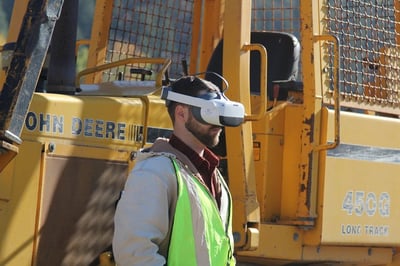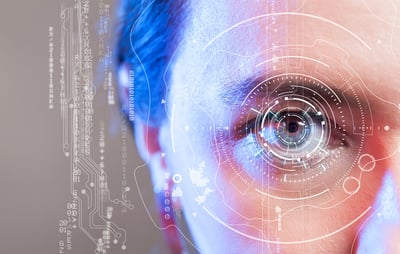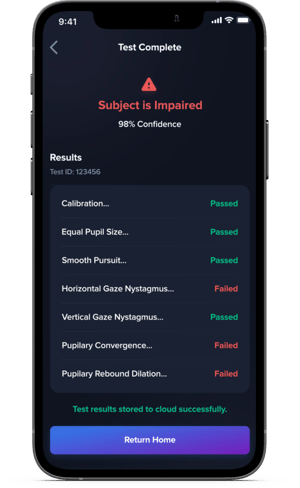Subscribe and Listen Now!
 |
 |
As cannabis legalization continues to gain momentum, employers face increasing challenges in ensuring workplace safety. In response, new real-time cannabis impairment testing technologies have emerged that enable employers to detect impairment and deter cannabis use in the workplace among employees in safety-sensitive jobs.
In this episode, we'll be diving into the current challenges with cannabis testing for safety-sensitive positions in the workplace and why it's markedly different from alcohol. Ken Fichtler, CEO at Gaize, joins us to discuss the science behind impairment detection and explore the process for rolling out real-time detection impairment screening for law enforcement and employers.
What you will learn:
➡️ The current challenges with how cannabis testing is measured
➡️ What the recent, largest clinical trial shows us about cannabis impairment
➡️ How Gaize's virtual reality technology is designed to detect cannabis impairment
The current challenges with how cannabis testing is measured
 There are various challenges safety-sensitive employers face as it pertains to testing for cannabis impairment. Most people look at this issue, and say, "Why can't we just have a breathalyzer for cannabis?"
There are various challenges safety-sensitive employers face as it pertains to testing for cannabis impairment. Most people look at this issue, and say, "Why can't we just have a breathalyzer for cannabis?"What the recent, largest clinical trial shows us about cannabis impairment
 Gaize's technology measures eye movement which is similar to how law enforcement officers have been detecting impaired individuals for years. Gaize takes these same tests and automates them using a virtual reality headset equipped with embedded eye-tracking sensors that capture high-resolution data and video throughout the screening process, and then the data from machine learning gets analyzed.
Gaize's technology measures eye movement which is similar to how law enforcement officers have been detecting impaired individuals for years. Gaize takes these same tests and automates them using a virtual reality headset equipped with embedded eye-tracking sensors that capture high-resolution data and video throughout the screening process, and then the data from machine learning gets analyzed.
The clinical trial was out of 350 participants that started out in a sober state. Participants consumed recreationally legal cannabis resulting in them being placed under the influence. The study measured how their eye movement changed while being high over time, providing over 500 million data points, which have been used to train Gaize's machine-learning models. This helped developers understand how eye movement changes over time in response to cannabis, and more precisely, track how impairment is experienced in real-time rather than focusing on the actual chemical in the body.
Gaize's technology does not have the capability to rate the level of impairment on a scale in terms of measuring whether somebody is a little high versus totally impaired. The product relies on the same methodology used by law enforcement, and if you're presenting common signs and symptoms of cannabis impairment, then that person is deemed impaired. If they're not showing those signs and symptoms, then they're deemed not impaired. However, Ken clarifies that if experts were to develop such a scale, Gaize would be able to adapt its product in order to comply with new regulations.
How Gaize's virtual reality technology is designed to detect cannabis impairment
 Gaize consists of three different software products including a VR application that runs the tests in a virtual reality headset, and available mobile applications for both iOS and Android devices, that pair to the VR headset. This allows the test administrator to start and stop tests and receive test results instantaneously. Once the test is finished, all of the data gets pushed up to Gaize's cloud server to be analyzed, which only takes about 30 seconds, before returning it to the mobile device. The entire testing process, from the time you hit the Start Test button to the time you have the results, takes about six minutes, which becomes stored on Gaize's web app. After logging into the website, you can view a video of the test, see the results, and see a map of where tests were performed if you're an organization that has multiple locations or job sites.
Gaize consists of three different software products including a VR application that runs the tests in a virtual reality headset, and available mobile applications for both iOS and Android devices, that pair to the VR headset. This allows the test administrator to start and stop tests and receive test results instantaneously. Once the test is finished, all of the data gets pushed up to Gaize's cloud server to be analyzed, which only takes about 30 seconds, before returning it to the mobile device. The entire testing process, from the time you hit the Start Test button to the time you have the results, takes about six minutes, which becomes stored on Gaize's web app. After logging into the website, you can view a video of the test, see the results, and see a map of where tests were performed if you're an organization that has multiple locations or job sites.
The video component is just as important for safety-sensitive employers as it is for law enforcement. Law enforcement has historically conducted tests such as finger tracking, which does not capture substantial evidence that a person has failed a sobriety test. So it becomes a situation in court where an officer identified indicators of impairment, but the defendant's attorney is fighting it by saying that the officer was not actually qualified or telling the truth, which then becomes a grey area.
Gaize's technology eliminates that doubt by capturing video of what's happening in real time, which allows people to accurately see signs and symptoms of impairment through eye movements, making the prosecution's case that much stronger. The same mentality applies to safety-sensitive employers providing an additional layer of validity when an employee presents indications of impairment that are then backed up by the product's analysis.
Roll out challenges and hurdles
This is a complicated space considering there are both federal and state regulations that come into play. Each individual state has a unique set of regulations that govern how employers can treat employees and how drug testing is authorized to be conducted, making it that much more complex. With that in mind, Gaize partnered with one of the nation's largest employment law firms, Ogletree Deakins, which offers a free hour-long consultation with those purchasing the product to ensure they're doing everything by the book, according to their state regulations. Additional steps for employers include modifying drug testing manuals and making sure policies are in compliance across the board. Ken believes the product creates a path forward for customers to use Gaize with confidence.
Considerations for cannabis impairment testing
One of the most commonly asked questions that clients come to Ken with is if Gaize is able to detect drugs other than marijuana as well - whether you are concerned about someone being drunk on the job, or an overseas employer seeing a spike in cocaine use in your workforce, the answer is yes. The product currently detects the same signs and symptoms of impairment that law enforcement can across the board. Each drug has a unique biological signature presented in the eyes which allows the software to detect indicators of impairment accurately.
The next chapter of Gaize
Long-term goals for this innovative technology include replicating the clinical trial in which they conducted for cannabis use and applying it to the previous drug types we mentioned such as cocaine. In fact, Ken confirmed they are currently conducting a trial capturing data on ketamine and they've already captured data on alcohol, with the intention of making the software more sophisticated overtime answering questions such as:
- What is their level of impairment?
- What drug are they impaired by?
- Could this be caused by a medical condition?
- Could this be caused by prescription drug use?
- Could this be caused by a lack of sleep?
The main focus
It appears that despite coming with initial challenges, from a business and safety perspective with the science to back it up, the risk is worth the reward. Ken looks forward to Gaize changing the narrative of the national conversation more towards a discussion of impairment rather than drugs. Historically drugs have been the main focus, but what leaders should be focusing on is impairment, regardless of the reason, and working towards creating a system for maintaining a safer workplace.
Resources:
- Visit Gaize's website here
-
Send an email to Ken@gaize.ai




.png?width=800&name=EP17%20HQ%20v1%20Ken%20Fichtler%202136%20(3).png)


Comments
Currently, there are no comments. Be the first to post one!